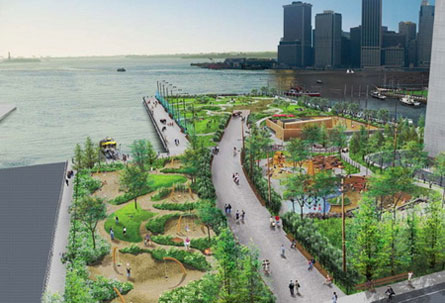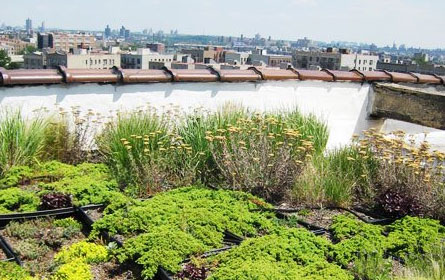Communities Drowned Out
Old tires. Invasive plants and rampant weeds. Mounds of garbage.
"Basically everything that ended up in the streets tended to end up in our riverway," said Miquela Craytor, executive director of Sustainable South Bronx.
Gotham Gazette on the Waterfront

.........................
Neglected National Parkland
Our parks columnist explores the national parkland along the New York Harbor -- an area most New Yorkers have never heard of.
.........................
The city has created a new plan for the ball fields on Randall's Island. Critics, though, are calling foul.
.........................
After three tries, a new Mass Transit Tunnel linking New Jersey and New York has broken ground. But advocates question whether this proposal will really ease traffic under the Hudson.
.........................
This is how she described the Bronx's Starlight Park -- a decrepit space, long-since abandoned by manufacturing companies who left behind remnants of contamination and debris.
This was, however, before her organization, and other local groups, intervened.
The revival of this park, and many others along the Bronx River waterfront, is thanks largely to Sustainable South Bronx, an environmental justice organization whose mission is sometimes stated as "greening the ghetto." Noting a lack of access to open spaces in their area, the organization's founder Majora Carter fought hard to secure a feasibility study for creating a greenway, which will eventually link restored parks up and down the Bronx River. To date, the project has secured nearly $30 million dollars, according to the group's Web site.
Today, Starlight Park is slated for a major renovation, which will include amenities such as ball fields, playgrounds, a floating dock and legitimate access to the visible – but often unreachable – Bronx River waterfront.
Sustainable South Bronx's activism has been admired nationwide, but community activism along New York City's coastlines is no longer a rarity, according to experts.
With a wave of development sweeping across the city's waterfronts, community-based groups are stepping up and making their voices heard -- initiating, advocating and constantly pushing for access in their neighborhoods. But even as the grassroots movement gains momentum, their priorities can sometimes get caught in a whirlpool of community, developer and city interest.
A Blue Movement
As the president and chief executive officer of the nonprofit Metropolitan Waterfront Alliance, Roland Lewis has seen the organization and power of grassroots groups along the city's shorelines.
"So many of these groups have taken it upon themselves to create access, use and participation in waterfront planning and development all across the city," said Lewis, whose organization is an umbrella of 400 local groups and agencies with ties to the New York and New Jersey coastline. "We sometimes call it a 'blue movement' and part of it is neighboring groups realizing that they have a stake."
Lewis said for most of New York's modern history, the waterfront "was cut off by industry, by roads, by rails. It became a place where no one wanted to be."
With many of these commercial enterprises leaving the coastlines, grassroots groups from Newtown Creek to the Hudson River are clamoring for their "stake" in the 578 miles of New York City waterfront -- 17 percent of the state's total coastline, according to the New York State Department of Coastal Resources.
The benefits to waterfront access are myriad for these communities -- a local economy stimulated by tourism and industry, the replacement of deteriorating brownfields, and the creation of recreation opportunities. The latter, said Lewis, is especially important for the outer boroughs, where the populations are traditionally underserved by open space.
"It's every person's right to be able to get to the water," said Lewis. "We can improve quality of life tremendously... especially for those of us who can't go out to the Hamptons."
Neighborhood and grassroots groups are in a unique position to push their agenda, according to Joan Byron, the director of Sustainability and Environmental Justice at the Pratt Center for Community Development. "There are things you can do from within government and you can only do from within government. But the power to advocate for specific projects is outside of government," said Byron. "Who else is going to do it?"
Organizations like Sustainable South Bronx, Friends of Brook Park and the Newtown Creek Alliance seem to be up to the challenge of trying to reconnect their constituents with one of the city's most valuable resources.
Community Voices Drowned Out
Judi Francis stands on a top level of a parking garage in Brooklyn Heights. She's facing toward the East River and the picturesque Manhattan skyline, but her gaze is downward at the proposed Brooklyn Bridge Park site.
The Brooklyn-Queens Expressway roars underneath, as Francis points out the future pedestrian entranceway to the park, now under-construction, which she deems hazardous.
"See, it will be very dangerous to cross there," she says. She shows me where her organization, the Brooklyn Bridge Park Defense Fund, a community-group opposed to current park plans, wanted to tunnel beneath the expressway to create a safer thoroughfare. "But we can't because where that strand of trees is, that will be a 20-story high-rise," says Francis, a resident of the area for 30 years and president of the defense fund.

That very high-rise, along with five others, has become a major point of contention between some area residents and the Brooklyn Bridge Park Development Corporation, a subsidiary of the Empire State Development Corporation, and a partnership of the state and the city. The governor and the mayor appoint their board. Francis charges that the city ignored years of community planning by local groups by erasing all recreational activities from park plans in favor of luxury condos, which the city says will help finance the project.
"One day I woke up like everybody in Brooklyn did, and I opened my New York Times, and a park that had been planned by the community all along the waterfront was suddenly transformed into a housing development with park-like elements," says Francis.
Francis, who says she speaks for 13 community associations and the local chapter of the Sierra Club, contends the condos have replaced a pool, skating rink and event venue, unofficially mapped by the neighborhood during 40 group sessions – making the future of the park a completely "passive" experience.
"You don't build a park with housing because the people who live inside the homes are not going to want people to tramp on their lawns," she said.
Francis isn't the only one disappointed in the plans. The Project for Public Spaces lists the Brooklyn Bridge Park in its design "Hall of Shame," along with other New York locales like Astor Place, Columbus Park Pavilion and the Federal Plaza.
"It's going to be beautiful but it will be limiting in terms of the amount of people and types of uses and flexibility to evolve over time," said Ethan Kent, vice president of Project for Public Spaces.
Kent said that waterfronts "are the face of the city" and should be designed to reflect the identity of an area. He said this was not the case for Brooklyn Bridge Park.
"Unfortunately it will be more of a suburban backyard or a Jamaica Bay, which again is beautiful, but not appropriate for the area," he said.
But Regina Myer, who heads the group charged with developing the site, the Brooklyn Bridge Park Development Corporation, said that she has received a tremendous amount of community support. This includes the likes of Brooklyn Bridge Park Conservancy and Community Boards 2 and 6.
"There were numerous community meetings that took place over the history of this project," said Myer. "It just so happens that the [Brooklyn Bridge Park] Defense Fund objects to our financial model."
Myer said these criticisms represent "one particular perspective" and that the housing complexes developed out of a plan to keep the park financed and maintained – with support from the neighborhood.
"The planning process really did evolve based on different community groups, financial constraints and physical constraints," said Myer. "I think people have recognized that there's no other source for maintenance and economic funds."
A Community Balance
The debate at Brooklyn Bridge Park points out the difficulties of balancing a community's vision with the feasibility of implementing and financing development.
"Waterfront planning projects around the world are undergoing this renaissance and shift in uses," said Kent. "So many of them are leading to conflict and frustration on the part of all parties."
Kent said under the current administration, community group's voices are often silenced.
"Unfortunately it has been something of a hallmark of the earlier years of the Bloomberg administration. A lot of the big projects sort of floundered and were led more by EDC [Economic Development Corporation]."
There are similar sentiments outside of Brooklyn. Back at the Sustainable South Bronx, Craytor said officials and developers occasionally labeled parts of their plans as "details," while they were high priorities to the community.
"Essentially our role was to say, 'No, this is what the community wants, this is what we were pushing for, so we have to find a different way,'" said Craytor. "If it wasn't for our presence in the room, I truly believe that certain elements would've disappeared."
Kent said that despite past planning, he feels positive about future development.
"We're still hopeful that with another term they might make community-based planning and public planning a real legacy of their administration," said Kent.
As Francis watches her dream park transform, however, she remains discouraged.
"It's the way the mayor has sort of transformed the city," Francis lamented. "Unless you're in a position of great wealth or great power, your voice means nothing."
Legal Ruling Puts a Cork on the Bottle Bill

On Monday environmental activists were supposed to be celebrating. The expansion of the state's bottle law was scheduled to go into effect, placing deposits on bottled water, increasing the handling fees stores and redemption centers get per can or bottle and directing 80 percent of unclaimed deposit money from bottling companies to the state. But that didn't happen.
On May 29 federal court judge Thomas Griesa issued an order preventing implementation of the entire law until April 1, 2010. Griesa's ruling came in response to a lawsuit brought by a group of bottled water companies that claimed the law was unconstitutional. The state can appeal the decision.
"Nobody could have predicted the judge's ruling. We were totally shocked," said Laura Haight, chief environmental associate of the New York Public Interest Research Group. The delay could now cost the state $115 million in unclaimed bottle deposits it was supposed to start collecting this year. And stores and redemption centers that were scheduled to see an increase in bottle-handling fees will lose that revenue.
Water bottling companies were upset that the law would have gone into effect just a month after it was signed by Gov. David Paterson, denying them, they said enough time to adequately prepare. "The amendment makes major changes to the bottle bill's framework and for the first time applies to bottled water producers and distributors, who have no experience with the law's provisions," read the complaint filed by the companies. "The short time frame for compliance with the bottle bill is arbitrary and irrational and thus violates plaintiff's substantive due process rights and unduly burdens interstate commerce in violation of the Commerce Clause."
After the bill passed, Haight said she realized the "timetable was very rapid," and expected legislators to address the concerns. They didn't. Haight said state leaders could not "agree on language."
The law also required all returnable bottles sold in the state to have New York State-specific codes. Companies said meeting such a requirement would be expensive, violate the Interstate Commerce Clause in the U.S. Constitution and would be hard to comply with on such short notice. Griesa ruled that this portion of the bill cannot be implemented or enforced at all.
The Fight for the Bigger Bottle Bill
Advocates have fought for years to have the law extended to include mandatory deposits on beverages other than soda and beer. They argue the expansion would increase recycling and reduce litter. Year after year, the Democrat-controlled Assembly would act on the legislation only to have Senate Republicans ignore it. But this year, with Democrats in control of both houses of the legislature, the fight was supposed to get easier. Again, it didn't.
Haight recalls that when she and like-minded advocates discovered that the bottle bill had been included in the budget agreement, they felt they had pulled victory from the jaws of defeat.
The bill, though does not go as far as they would have liked. For one thing, it adds deposits only to bottled water, leaving fruit juices, energy drinks and all the other soft drinks that have proliferated over the past 30 years out entirely.
Beverage companies ran television and radio ads against the expanded bottle bill across the state. They complained the expansion of deposits to drinks other than soda would drive up prices and hurt their business. According to NYPIRG, groups opposing the legislation gave over $2 million to state political parties and politicians in the last election cycle.
In the days leading up to the budget deadline, Haight said, she was just as unsure of what was included in the budget deal between the state's top Democratic leaders as everyone else. "We didn't know what was going on. We were in the dark like everyone else. We didn't know, and the legislators didn't know, either," she said.
Finally, when the three men in the room emerged to share the details, Haight was elated to find that bottle bill was part of the deal. But some legislators were not. According to Haight, "There was a lot of consternation among members of the Senate, as they had not been consulted [about the contents of the budget deal], and some senators went to work to try to unravel the deal."
Lobbyists representing the beverage industry walked the Capitol's halls complaining ferociously to legislators. Environmental groups started a pressure campaign of their own by having constituents call the office of Senate Majority Leader Malcolm Smith. "Our calls shut down his phone system," said Haight. "To this day don't know how we did it."
Those voicing concerns about the bill and its timetable also became more clamorous, though. Legislative leaders acknowledged the June deadline might be too much to ask of bottlers and indicated they were interested in taking action to give them some breathing room. The action did not materialize, though, and on May 18 the International Bottled Water Association, Nestle Waters North America and Polar Beverages filed a lawsuit challenging the bill's constitutionality.
Kennedy Weighs In
Another shocker for environmental groups occurred when environmental advocate Robert Kennedy came out against the bottle bill and signed an affidavit in support of the beverage companies' lawsuit. In an op-ed for the New York Times titled "A Bottle Bill That Will Rot Your Teeth," Kennedy attacked the bill as being "cooked up by lobbyists for makers of sugared drinks and their allies in the legislature." Kennedy wrote that the bill was absurd for adding deposits on bottled water but not sugared beverages like tea and sports drinks. Kennedy also said the bill would hurt municipal recycling efforts by removing water bottles from their programs.
Environmental advocates were enraged that Kennedy hadn't consulted them before taking his position public. They also noted that he runs a water-bottling company. Kennedy's Keeper Springs sells bottled water and donates its profits to environmental causes. "At first I just thought, 'He's got a water-bottling company,'" said Haight.
Haight said that the legislature did not include flavored beverages because grocery store owners complained that bottles that once contained sugary drinks would be messy and dirty their stores. She said that municipal recycling programs support the bottle bill. "Our coalition includes municipal recyclers who were pushing for this," she said.
No Redemption
It is not just the state that will lose money because implementation of the bill has been delayed. "This is going to impact every place where you return bottles," said Sheila Rivers, chairwoman of the Bottle and Can Redemption Association. "Corner stores, local markets and bodegas are all going to feel it. This will have a huge impact on New York City," she said.
Delaying implementation of the entire bottle law for a year will hurt stores and redemption centers, said Rivers, because the law was scheduled to increase the handling fee they receive, from two cents to three-and-a-half cents per bottle. That increase, Rivers said, is decades overdue. "We have no way to raise prices when costs go up," she said.
On top of that, she noted, redemption centers have been gearing up to deal with the influx of now redeemable water bottles. "Up until Friday we thought this was going to start," said Rivers. "I was in a store on Monday where they had big signs saying, 'We take water bottles starting June 1.' We had to plan for this." Rivers said many redemption centers will probably have to lay off staff they hired in anticipation of the increased workload. "A lot of redemption centers have closed this year, and a lot more will close if we have to try to hang on until next April," she said.
What's Next?
Representatives of water bottling companies say they would like to see all bottled beverages have deposits. "What we think needs to happen right now is for the bill to be fixed to include all bottles, and to make sure unclaimed deposit revenue is funneled back to the municipalities to support community-based recycling," Trish Wexler, spokeswoman for Nestle Waters North America told the Associated Press.
Advocates say it is ludicrous for bottled water companies to say they back expanded recycling when they sued to bring an end to the bottle bill.
For now, activists are waiting to see how Attorney General Andrew Cuomo reacts to the ruling to see how the state might go ahead in addressing concerns about the bill. "We will know what the attorney general's office will do in the coming weeks," said Haight, "but the question is, will the legislature do their part if they have a role to play? Right now it seems they are comfortable to sit back and let the governor take the blame, but we aren't willing to do that."
Toxic Town

New York City may be known for its world renowned-parks and unfiltered drinking water, but the five boroughs are also home to some of the state's most polluted waterways and wastelands.
Some, like Fresh Kills, get attention. Others, like Newtown Creek, struggle for remediation for decades.
According to the U.S. Environmental Protection Agency, there are 222 Superfund sites -- or abandoned toxic areas in desperate need of remediation -- in New York State. Last month, the federal government proposed to add another one to that list: the Gowanus Canal.
What that debate has shown us so far is remediation may be the easy part of toxic cleanup. Figuring out how to do it, who to blame and how to pay for it is where the real debate begins.
Hold your nose.
Gotham Gazette is unveiling some of the city's most polluted areas and the debates behind their remediation, from Staten Island's North Shore to Brooklyn's industrial waterways.
The Gowanus Canal: Everyone agrees the Brooklyn waterway and the area surrounding it need a cleanup, but residents and others differ on how to do it.
--Joshua Verleun, an attorney with Riverkeeper, writes that the area should be designated a Superfund site.
-- David Von Spreckelsen, a senior vice president of Toll Brothers, which hopes to build along the canal, argues the city has a better plan.
Newtown Creek: The estuary separating Brooklyn and Queens has earned the dubious distinction of being one of the country's most polluted waterways. Residents, advocates and others have long pleaded for a cleanup -- to no avail. Is that finally about to change?
Staten Island's North Shore: This area of approximately 5.2 square miles includes more than 20 sites the government or residents consider contaminated -- many of them close to apartment buildings and houses. In March, the community learned of further dangers.





